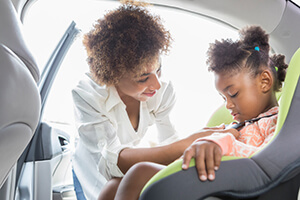Make sure all ages are riding safely
This week is National Child Passenger Safety Week, but the change in seasons is a great time to make sure that your car has everything needed for a Minnesota winter.
When you check if you need new tires, windshield wipers, ice scrapers or roadside emergency kits — be sure to pay special attention to make sure your child’s car seat and that it is correctly installed. Road injuries are our country’s leading cause of preventable injuries and deaths in children. And it is estimated that a correctly installed car seat can reduce the risk of death by as much as 71 percent.
See the link in the adjacent callout to find out how you can have your child’s car seat inspected. In St. Cloud, car seat check-up events are scheduled monthly at Gold Cross Ambulance Garage. Several adjacent counties and cities also provide car seat checks by appointment.
Regularly check the seat to make sure it hasn’t come loose. It should move less than one inch from side to side at the belt path (using the latch system or seat belt).
While every parent should be familiar with the height and weight limits of each child’s seat — in general, the type of car seat a child should use is as follows:
From birth to age 2: Use a rear-facing car seat
If a crash were to occur, riding in a rear-facing car seat will help protect your child's head, neck and spine. So don't be in a rush to move your child under age 2 into a forward-facing seat. Children may stay rear-facing longer than age 2 in a convertible seat, based on the seat’s height and weight limits. A rear-facing seat should be placed in the back seat of your vehicle. Check your owner’s manual for your vehicle and car seat for correct placement. Never place a rear-facing seat in front of an airbag.
From age 2 to age 5: Use a forward-facing car seat
A recent study by SAFE KIDS Worldwide found that about two out of three parents were not using the tether on their child's forward-facing seat. Without use of the tether, your child's car seat could tip dangerously forward during a crash. Which could make your child vulnerable to hitting their head on the back of the seat in front of them or another passenger.
The tether — which appears as a strap with a hook — at the top of your child's car seat is supposed to attach to one of the anchors on your vehicle. Usually these anchors are found on the back of the seat, the ceiling or the rear shelf of the vehicle. Find out more on this topic from SAFE KIDS Worldwide.
Children should ride in a forward facing harnessed seat (convertible or combination) when they have outgrown their rear-facing seat. Children should ride in a harnessed seat as long as possible according to the height and weight limits on the seat.
From age 5 until adult seat belts fit appropriately: Use a booster seat
Until your child is age 8 or 57 inches tall (4’9”), your child does not meet the recommended age or height for a seat belt. It is recommended to keep your child in a booster based on their height, rather than their age. Booster seats must be used with both a lap and should belt. It will fit your child properly when the lap belt lays across his or her upper thighs (not over the stomach) and the shoulder belt lays across his or her chest (not over the neck). Some booster seats have a high back, others come without a back. A booster without a back can only be used in vehicles and seating positions with a head rest.
Adult seat belt
Your child should be at least 4’9” tall to correctly fit into an adult seat belt. They may be ready for an adult seat belt when then are able to sit flat against the seat back with their knees bent comfortably over the seat edge. Their feet should touch the vehicle floor without slouching.
It is considered the best practice to have a child ride in the back seat of a vehicle until they are 13 years old.
